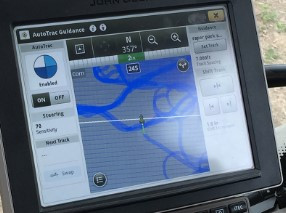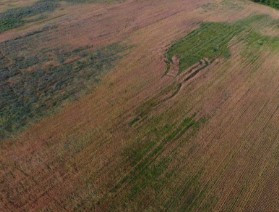By Kaine Korzekwa
When it comes to nifty farm gadgets and technology, there are many neat tools. Tractor guidance is definitely one of them, thanks to how it helps farmers better use their resources.

Tractor guidance screen as seen during a fertilizer application.
Tractor guidance allows farmers to be more precise when using a tractor to perform tasks in the field. These tasks include planting, spraying herbicide, and applying fertilizer. But how does this precision turn into savings for a farmer?
Amanda Ashworth of the United States Department of Agriculture’s Agricultural Research Service and a team of researchers worked to find out. Their results point to benefits for small farms, many of which do not currently use this tool.
“Precision agriculture technologies improved the on-farm efficiencies by up to 20% based on our work,” Ashworth says. “There is a lot of room for more adoption of the technology on small farms. This would possibly lead to economic and environmental savings.”
A farmer in a tractor makes a series of passes across a field to plant seeds or spray chemicals. Anywhere there is overlap in these passes is inefficient because it’s an unnecessary double application. In addition to overlap, gaps of the field not covered in passes are also bad. It’s a missed opportunity to improve crop production.
Tractor guidance uses GPS to help reduce these overlaps and gaps. It also allows researchers to track and record tractor movements. The researchers helped improve an existing calculation to best measure these overlaps and gaps. It particularly helped where the tractor turns around at the end of a row.

Aerial photo of spatial variability within a field as part of a tractor guidance study evaluating how topography and field shape variations influence precision agriculture efficiencies in pasture systems.
The team’s results suggest that tractor guidance reduces overlaps by up to 6% and gaps by up to 16%. Farmer’s profits are made on small margins, so a small decrease in fertilizer costs, for example, can be very beneficial. Also, fertilizer that runs off a field can harm waterways, so being able to apply just the correct amount can benefit the environment.
While many large crop producers use tractor guidance, they only make up about one fifth of farms in the United States. The rest are small farms. These smaller farms are often slower to learn about and adapt to these new technologies.
All combined, increases in efficiencies with tractor guidance on small farms could result in saving U.S. producers more than $10 million.
The precision tool has other benefits, too, such as letting drivers operate in low light to get more work done during the evening.
“Not all agricultural areas receive information on technology at the same rate, so there is work to be done here,” explains Ashworth. “The small farm systems have high potential for adoption, which would impact the greatest numbers of farms.”
Click here to see more...